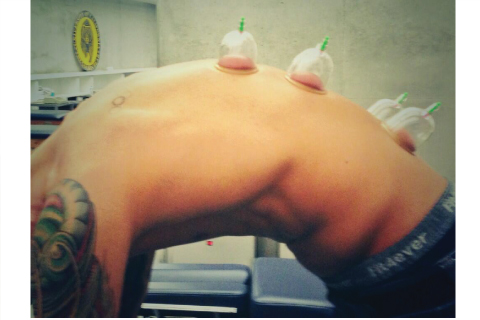Acupuncture Works

Several years ago, I stopped at a restaurant on my way to Austin, where I was to begin studies in acupuncture and Oriental medicine. The waitress asked where I was headed and replied to my answer with misunderstood enthusiasm, "Agriculture School?! My son is studying agriculture!" "No ma'am,” I explained. "Acu-puncture. You know—tiny needles?" After assuring her it had nothing to do with crop dusting or fertilizers, she began to understand. Today, with Kobe Bryant and swimmer Anthony Ervin tweeting photos mid-treatment, Celine Dion and Natalie Portman praising acupuncture for help with infertility, and actresses sporting cupping marks on the red carpet, most people have heard a little something about acupuncture and Oriental medicine. Still, it's novel enough in the U.S. to require a little more explanation.
"Needles. Yeah, I don't really like needles." This is the most common response I receive after asking if someone has tried acupuncture. I can almost see the trauma of childhood immunizations dance behind their eyes as they recall their first experiences with needles. Even for adults, getting shots isn't pleasant. The fear of pain associated with needles is common and understandable. Fortunately, acupuncture needles are a different beast entirely. These needles are extremely thin, about the size of a human hair; about ten can fit inside a normal hypodermic needle. The tiny size of acupuncture needles makes insertion virtually painless, and most practitioners are happy to demonstrate on themselves if you need that extra bit of proof before jumping in. The needles are gently inserted into the skin and stimulated to cause a dull, heavy sensation called "qi" (“chee”).
So, how does it work? Practitioners the world over explain it differently, but at the core of every answer is the concept that Oriental medicine is built upon a foundation of balance. When the body is out of balance, illness follows. Restoring balance restores health. Balance here refers to aspects of bodily health, including proper function of organs, organ systems, the nervous system, musculoskeletal integrity, and the body's ability to adjust to changes in the season or environment. Everything is connected, and Oriental medicine is a unique treatment modality in recognizing the importance of mental–emotional health as a factor in restoring or maintaining wellness. These factors combine with information about diet, lifestyle, and stressors, such as family or work, to focus treatment on the cause of illness rather than just symptoms. When one or more of these factors affects the body's ability to function, the body is out of balance. During an initial exam, we ask questions to determine how these factors are affecting someone. Treatments last between 45–60 minutes, and six to eight treatments may be required, depending on the severity of the condition (some situations require fewer).
Acupuncture in the U.S. often refers to Oriental medicine as a whole, which includes more than just needles. Other techniques in this medicine include cupping, moxibustion, Tuina, and herbal medicine. Remember when Gwyneth Paltrow made headlines when her backless dress at a film premier revealed round bruises? Those marks are the result of cupping, the use of suction cups to bring stagnated blood, lymph, and other fluids to the surface so the body can repair the area. Moxibustion uses a smoldering herb or charcoal to create heat on the surface to soothe pain or strengthen organ function. It may be used when treating conditions such as chronic diarrhea or pain associated with PMS. Tuina (“twee-nah”) is a form of Asian bodywork that manipulates muscular, fascial, or connective tissues to heal structural injuries. And, although herbal medicine is mentioned last, it is one of the more powerful tools at a practitioner's disposal. The combination of herbal medicine and acupuncture is so important to achieving positive results that for some conditions, I prefer not to see a patient unless they agree to both. If we want to paint the picture of perfect health, acupuncture is the paintbrush and creates the needed momentum toward restoring health. Herbs are the paint, the substance that makes a treatment last.
The effectiveness of acupuncture and Oriental medicine is proven across the country every day. Top hospitals around the world, including the Mayo Clinic, MD Anderson Cancer Center, and Johns Hopkins, provide acupuncture in conjunction with conventional care. A growing number of medical practitioners combine the best of Oriental medicine with conventional biomedicine to give patients more options in health care. When seeking Oriental medical treatment, it is important that the patient seeks qualified practitioners. Licensed acupuncturists (LAc.) are the only health care practitioners who are required to accumulate almost 3,000 hours of clinical and classroom training that specifically covers needle manipulation, clean needle techniques and safety, and traditional Chinese medical theory. They are also required to pass four national board exams specific to acupuncture and Oriental medicine. In contrast, physicians, physical therapists, chiropractors, and podiatrists may practice acupuncture or dry needling in Texas with 100 hours or less of acupuncture training. As with any form of care, experience and training make a difference.
Austin is a fantastic city for acupuncture. The capital of the Lone Star state has one of the highest numbers of acupuncturists per capita of any American city. When natural, holistic medicine is part of getting well and staying that way, Austinites are in the right place. Talk to friends who have tried acupuncture. Seek out qualified practitioners who speak your language and can thoroughly explain how treatment can improve your unique condition. Look for providers who put you as the lead of your health care team and empower you to make decisions about your treatment. Enjoying life starts with feeling healthy. It’s not always easy and it may take time, but returning to health is worth the effort. Acupuncture can help.






